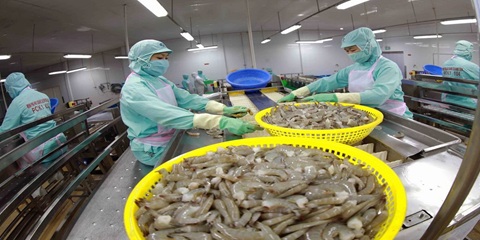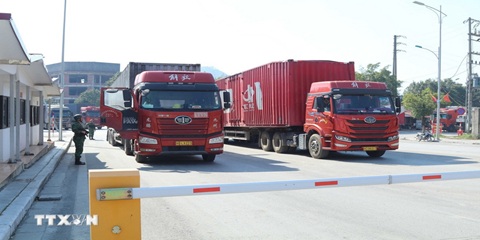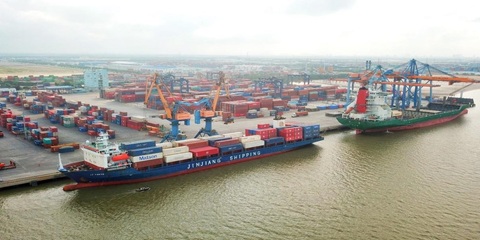Want to be in the loop?
subscribe to
our notification
Business News
WHOLESALE ACTION SET FOR EXPORT GAIN
As growing risks in the global market are posing challenges for Vietnam to maintain its growth prospects at a high level and realise its big export target this year, the government has requested new measures to bring the situation under control.
The government in its resolution for its February cabinet meeting released last week ordered ministries and localities to closely follow the international and regional situation and the policy revision of nations with a view to taking the initiative in analysing, forecasting, and formulating proper scenarios on boosting macroeconomic stability and quickening socioeconomic development.
“All difficulties must be removed for enterprises and investors so that their performance can be boosted soon, with the generation of more employment and livelihoods for people,” the resolution said. “Breakthroughs in institution, infrastructure, and education must be accelerated, especially in reviewing legal regulations as a prime priority in favour of enterprises and people.”
The government also required ministries and localities to quicken the reduction and simplification of administrative procedures, improve the business climate, and facilitate and reduce costs for investment and business activities.
The State Bank of Vietnam (SBV) is ordered to soon reduce interest rates and create favourable conditions for enterprises and people to access bank loans. Notably, credits must be focused on sectors that can serve as key growth momentum such as consumption, investment, and export.
The Ministry of Finance, meanwhile, must soon submit to the government for approval of new policies on exempting, reducing, and deferring the time of payment of taxes, fees, and land rental in order to help enterprises and people out of difficulties.
The government also required the Ministry of Industry and Trade to find out solutions to increase exports and closely control imports, and take advantages of commitments in signed free trade agreements in order to expand export markets, while also having to boost the negotiation and signing of new free trade agreements, and expand export markets in the Middle East, Africa, and Latin America.
The ministry is now working with Vietnam’s trade offices overseas to seek more information and demands from the markets where they are located so as to timely provide consultancy for the government and the prime minister on how to boost exports to these markets.
The Ministry of Planning and Investment (MPI) has warned of major risks in the global markets, which can affect the Vietnamese economy, mostly exports. The country’s total export-import turnover is nearly double its GDP, thus, it is prone to external shocks.
Specifically, while the country’s GDP last year hit $409 billion, its export-import turnover was 1.78 times higher, reaching $732.5 billion, up 9.5 per cent on-year
Vietnam’s GDP expanded from $21 billion in 1994 to $409 billion in 2022. Exports of goods and services, valued at $55 billion in 2007, soared to $371.85 billion in 2022 – up 10.6 per cent. Imports were valued at $360.65 billion – up 8.4 per cent on-year.
Looming risks
However, Prime Minister Pham Minh Chinh noted, “The macroeconomic situation remains not really solid as it is facing high pressure in inflation, coupled with external instabilities including geopolitical tensions and a shrink in export markets.”
“Our big export markets have been reducing their import demands, and this has affected enterprises’ export orders and supply chains,” PM Chinh said. “In the first two months of 2023, disbursement of foreign direct investment hit $2.55 billion, down 4.9 per cent on-year. Meanwhile, the implementation of many policies to support enterprises and people remains at a very slow pace.”
The government has required the SBV to soon submit to it for promulgation of a new decree on amending and supplementing Decree No.31/2022/ND-CP dated May 2022 on the 2 per cent lending rate support from the state budget for enterprises, cooperatives and household businesses via commercial banks
In January 2022, the National Assembly allowed the use of a maximum of VND40 trillion ($1.74 billion) for this 2 per cent lending rate assistance package. However, the SBV reported that by late last year, disbursement from this initiative remained at a very slow pace, standing at only over VND134 billion ($5.83 million) or more than 0.3 per cent of the total.
“Businesses’ performance remains in big difficulties. The number of enterprises drawing from the market is still very high. This will affect our efforts to generate employment,” PM Chinh said.
In the first two months of this year, according to the General Statistics Office (GSO), the number of enterprises whose performance was halted reached 3,800, up 9.7 per cent on-year. The number of businesses with halted operations and awaiting dissolution hit about 2.640, up 37.5 per cent; while the number of those having completing dissolution procedures stood at 1,170, down 5.4 per cent.
However, under a GSO survey on manufacturing and processing enterprises in Q4 of 2022, 31.5 per cent of respondents expect their performance in Q1 of 2023 to be better than in Q4 of 2022, and 37.3 per cent expect their business will become stable in Q1 of 2023.
In which, Vietnamese private enterprises show the most optimism with 70.3 per cent said their performance in Q1 of 2023 will be better than Q4 of 2022. Such rates are 68.9 and 65.3 per cent for state-owned enterprises and foreign-invested enterprises, respectively.
In its latest Global Economic Prospects report released in January, the World Bank stated, “The crisis facing development is intensifying. Our latest forecasts indicate a sharp, long-lasting slowdown, with global growth declining to 1.7 per cent in 2023 from 3 per cent expected just six months ago. The deterioration is broad-based: in virtually all regions of the world, per-capita income growth will be slower than it was during the decade before COVID-19. The setback to global prosperity will likely persist.”
According to the World Bank, the global growth expected to decelerate sharply to 1.7 per cent this year will be “the third-weakest pace of growth in nearly three decades, overshadowed only by the global recessions caused by the pandemic and the global financial crisis.”
Under the bank’s calculations, the US, the euro area, and China are all undergoing a period of pronounced weakness, and the resulting spillovers are exacerbating other headwinds faced by emerging market and developing economies. The US is expected to grow only 0.5 per cent this year, after a rate of 5.9 per cent in 2021 and 1.9 per cent last year. The euro area is predicted to grow 0 per cent this year, following 5.3 and 3.3 per cent in 2021 and 2022, respectively.
After the strong rebound in 2022, growth in Vietnam is expected to moderate as the growth of exports to major markets slows. Economic growth is projected at 6.3 per cent in Vietnam, the World Bank stated, adding, “Vietnam’s key export markets such as the US and the EU are projected to suffer from difficulties.”
New expected outlook
The Central Institute for Economic Management under the MPI has sketched out two scenarios for the Vietnamese economy in 2023, based on the record goods export turnover of $371.5 earned last year and if the global situation warms up this year.
Under the first scenario, the export turnover will increase 7.21 per cent, meaning $398.66 billion, while under the second scenario, the rate will be 8.43 per cent, equivalent to $403.2 billion.
According to the said GSO survey, 31.4 per cent of respondents said their production volume is likely increasing in Q1 of this year, and the rate of those forecasting that their production will stabilise was 38.5 per cent.
When it comes to export orders, 42.7 per cent of surveyed enterprises predict that their export orders will stabilise in the current period. Only a quarter of respondents predicted that these types of orders will increase in this quarter.
The government has set a target that in this year, Vietnam’s total goods export-import value will be about $795 billion, up about 8 per cent against this year. In which, the export turnover will be $398 billion – up over 8 per cent on-year. The trade surplus will stay at about $1 billion, far lower than the $11.2 billion recorded last year.
Source: VIR
Related News

VIETNAM’S SEAFOOD EXPORTS HIT OVER US$10 BILLION IN JAN-NOV
Seafood export revenue in November alone amounted to nearly US$990 million, up 6.6% year-on-year. Key product groups posted solid gains. Shrimp exports rose 11.7% to over US$385 million, supported by strong demand for whiteleg shrimp and lobster. Tra fish shipments increased 9.7% to almost US$197 million, while marine fish, squid, and mollusk exports maintained their recovery.

VIETNAM’S AGRO-FORESTRY-FISHERY EXPORTS HIT NEW RECORD IN JAN-NOV
Vietnam’s agro-forestry-fishery export revenue reached an estimated US$64.01 billion in the first 11 months of 2025, up 12.6% year-on-year and surpassing the full-year record of US$62.4 billion set in 2024. Agricultural exports reached US$34.24 billion, up 15% year-on-year, while livestock products brought in US$567.4 million, a 16.8% increase. Seafood exports rose 13.2% to US$10.38 billion, and forestry products earned US$16.61 billion, up 5.9%.

HANOI REPORTS RECORD-HIGH BUDGET REVENUE IN 2025
Hanoi’s budget revenue is estimated to reach VND641.7 trillion in 2025, the highest level ever recorded and nearly 25% above the revised target, according to a report by the municipal government. Data from the city’s socioeconomic performance review shows that total state budget collections in 2025 are projected to reach 124.9% of the adjusted plan and rise 24.9% from 2024, the Vietnam News Agency reported.

VIETNAM, CHINA TO PILOT TWO-WAY CARGO TRANSPORT AT LANG SON BORDER
Vietnam and China will launch a one-year pilot program on December 10 to allow two-way cargo transport through the Huu Nghi–Youyi Guan international border gates in Lang Son Province, reported the Vietnam News Agency. The Dong Dang-Lang Son Economic Zone Management Board said the trial aims to reduce transport costs and improve customs clearance capacity.

VIETNAM’S IMPORT-EXPORT VALUE NEARS US$840 BILLION IN JAN-NOV
The total value of Vietnam’s imports and exports was nearly US$840 billion between January and November this year, the highest level ever recorded, according to the National Statistics Office. In its latest report on the country’s socio-economic performance, the National Statistics Office highlighted a series of positive economic indicators, with trade emerging as one of the strongest drivers of growth.

OVER 19 MILLION INTERNATIONAL VISITORS COME TO VIETNAM IN JAN-NOV
Vietnam received more than 19.1 million international visitors in the first 11 months of 2025, a 20.9% increase year-on-year and the highest level ever recorded, according to the National Statistics Office. The figure surpasses the full-year record of 18 million arrivals set in 2019, before the Covid-19 pandemic. Nearly two million foreign visitors arrived in November alone, up 14.2% from October and 15.6% from the same period last year.
























